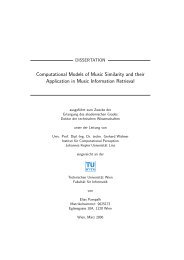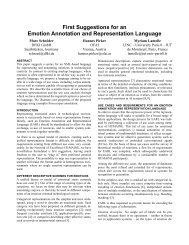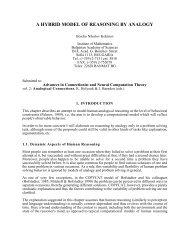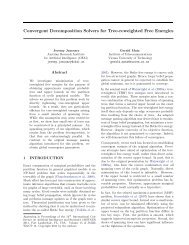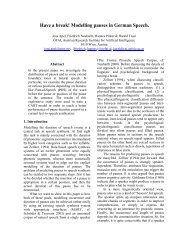Global Musical Tempo Transformations using Case Based ... - OFAI
Global Musical Tempo Transformations using Case Based ... - OFAI
Global Musical Tempo Transformations using Case Based ... - OFAI
You also want an ePaper? Increase the reach of your titles
YUMPU automatically turns print PDFs into web optimized ePapers that Google loves.
Expression and <strong>Musical</strong> Structure Firstly, expression is used to clarify<br />
the musical structure (in the broad sense of the word: this includes metrical<br />
structure, but also the phrasing of a musical piece, harmonic structure<br />
etc.). The research by Sloboda mentioned above [110] showed the influence<br />
of metrical structure on performances by having pianists perform the identical<br />
sequences of notes, differing in the position of the bar lines. The pianists<br />
varied their performances such that e.g. the notes at the beginning of measures<br />
were played louder and more legato than other notes. Furthermore, he<br />
observed that the more advance the performers were, the more they utilized<br />
this kind of expression, and the better listener’s were able to transcribe the<br />
performed music correctly. This is a clear indication that expression is used<br />
to clarify metrical structure.<br />
Phrase structure also has a salient effect on performance. Phrases were<br />
found to start and end slow, and be faster in the middle [59] . Moreover,<br />
Todd [116, 117] invented a model that predicts the level of rubato of a given<br />
musical piece, given a hierarchical grouping structure of the piece. The predictions<br />
of this model are similar to the rubato patterns in professional performances<br />
of the piece. Gabrielsson [42] found that pianists performing Mozart’s<br />
Piano Sonata K. 331, tended to lengthen note durations considerably at the<br />
end of phrases. Similarly, he found the tones to be relatively loud in the<br />
middle of the phrases and relatively soft at the beginning and end.<br />
Another form of structure that influences performance is harmonic and<br />
melodic tension. Harmonic and melodic tension are commonly defined by<br />
reference to the circle of fifths (where the tension is low for notes or chords<br />
that are close together on the circle of fifths and high for those that are<br />
far apart) [77]. Palmer [90] calculated a positive correlation between note<br />
lengthening and tension. Contrastingly, no correlation was found between<br />
note intensity and tension. In the same article, Palmer showed that melodic<br />
expectancy (the extent to which an implied continuation of a melody is actually<br />
realized (see also section 3.5.1 on the Implication/Realization model)<br />
did correlate positively with note intensity (unexpected notes were played<br />
louder), but not with note lengthening. As an explanation of the fact that<br />
the expression of tension-relaxation and melodic expectancy are realized in<br />
unrelated ways, Palmer notes that the two phenomena manifest themselves<br />
on different time scales; tension-relaxation is a phenomenon at the level of<br />
phrases and sub phrases (that is, a large time scale), whereas melodic expectancy<br />
is manifest from note to note, i.e. on a smaller time scale.<br />
In a general survey of the relation between expression and musical structure,<br />
Clarke [24] proposes the interesting view that expression is tied to<br />
structure by a limited set of rules (like the rules proposed by Sundberg and<br />
co-workers citeSundberg91a,Friberg91, see section 2.2.2). Hence, the diver-<br />
11




